“Hip-Hop is the culture of oppressed Black and Latino people that has, I guess, kind of flipped the political end of music and art on its head. Hip-Hop is the opposite of politics. Politics separates people. Hip-Hop brings people together.”- Emilio “Buddha Stretch” Austin
What is Hip-Hop?
Hip-hop is an umbrella term that includes several dance styles that are highly energetic and athletic. Hip-hop dance forms began as social dances that expanded to respond to socioeconomic conditions faced by marginalized African-American and Latinx youth in inner cities. These dance styles hold the meaning and values of the community, resulting in a cultural movement that gained widespread attention through media that has led to its global popularity today.
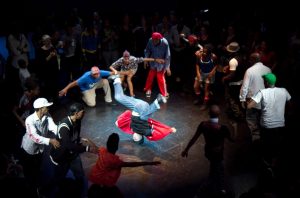
Watch This
The History of Hip-Hop in the Bronx.
Hip-Hop Characteristics
Africanist Aesthetics
Hip-Hop dance forms are situated in Africanist aesthetics that communicate the culture’s traditions, values, and heritage. Dance scholar E. Moncell Durden identifies the cultural characteristics as “individuality, creativity, improvisation, originality, spirituality, stylization, dance posture (bending forward from the waist with the knees bent and the spine slightly curved), vocalization, pantomime, percussion, competition, polyrhythm, and polycentrism.”
Cultural Connections
For more information see the New World Encyclopedia entry for African Dance.
https://www.newworldencyclopedia.org/entry/african_dance

The Components of Hip Hop Dance
Hip-Hop is a cultural expression characterized primarily by five foundational components: graffiti, deejaying, emceeing, breaking, and knowledge.
Graffiti is“the visual language of the hip-hop community” (Durden). Graffiti gained attention in the late 1960s when political activists illegally “tagged” or marked public places in defiance of government policies. Later, crews used graffiti to claim territories.
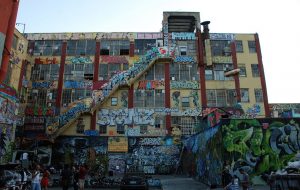
Deejays (DJs), or disc jockeys, emerged as “the sounds and memories of the community” (Durden). DJs initially hosted dance parties as part of social events. Through their experimentation with turntables and records, DJs found innovative ways to manipulate, isolate, extend, and loop the musical rhythms for dance.
Emcees (MCing) are also known as the Master of Ceremonies. It was the emcees’ responsibility to pump up the crowd during parties. They became the community’s voice, using improvised spoken words and rhymes to tell the social conditions and experiences of the community, often shedding light on social injustices. This is known as rap today. Rapping has roots in West Africa, where griots, or storytellers, were responsible for preserving their people’s “genealogies, historical narratives, and oral traditions” (Britannica).
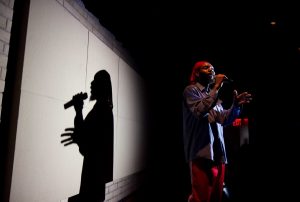
Breaking is considered the original street dance associated with the Hip-Hop subculture. Breaking is improvisational and emphasizes the dancer’s style and athleticism while responding to the musical accompaniment, typically funk music.
Knowledge is the culmination of the Afro-diasporic cultural components to recover power from oppressive systems through spiritual and political awareness. This refers to having gratitude for your heritage that will give you insight into your future and self-understanding.
During the 1950s, residents living in the East Coast boroughs of the Bronx, New York City, struggled to survive in dire socio-economic conditions caused by poor city management. The community was plagued by the decay caused by the destruction of homes with the Cross Bronx Expressway construction. Families lost their homes and left the city to move into the suburbs. As people left, local businesses closed, and job opportunities became scarce, causing high unemployment rates. Government-subsidized houses known as the projects were built to provide affordable housing to low-income families. These became overrun by gangs and a rampant drug scene.
By the 1970s, poverty among residents had significantly increased. In the 1977 World Series between the New York Yankees and Los Angeles Dodgers, Howard Cosell announced, “the Bronx is burning” (Wikipedia). “For a couple of years, fires had routinely erupted in the South Bronx” as people burned down buildings hoping to collect insurance money (Wikipedia). From 1973 to 1966, the Bronx “lost 600,000 jobs, more than 5,000 families were displaced, and some 30,000 fires were set in the area” (Durden).
Hip-Hop emerged from this socio-economic turmoil in the early 1970’s. Marginalized inner-city African American and Latinx youth found an outlet to release frustrations through a lifestyle informed by shared living experiences that brought the community together.

Louisiana Connection
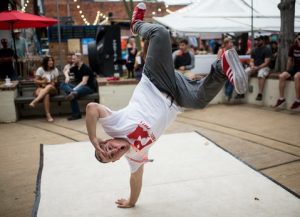
Terrance Michael Morgan: Born and raised in Louisiana, he is on a mission to improve the lives of today’s youth by promoting positive youth development through the act of art, dance, speaking and more. Morgan began as a self-taught dancer doing mostly free-style (improvisation) where he was introduced to the hip hop dance style of B-Boying. This led to him becoming an original member of a local dance group Kabuki Kru. He began traveling throughout the U.S. to participate in underground B-Boy Battles and continued learning about a variety of dance styles. He currently travels as a motivational and educational speaker/artist that performs in schools, libraries, festivals, and more weekly to spread his message of positivity. He has been affiliated with the Acadiana Center for the Arts since 2004 and is also currently a touring artist for Young Audiences of Louisiana.
Clive Campbell
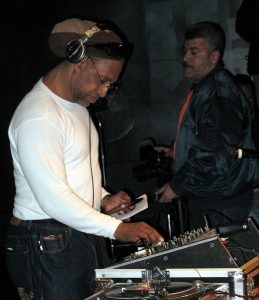
One of the earliest known DJs is Jamaican immigrant Clive Campbell, known as DJ Kool Herc. Kool Herc is considered a pioneer of Hip-Hop for developing a style of music that would lay the foundation for hip-hop music, giving him credit as the “Father of Hip-Hip.”
DJ Kool Herc hosted parties where he invented the “merry-go-round” technique. Unlike other DJs, Kool Herc didn’t play songs continuously; instead, using two turntables, he isolated the instrumental break in the music and extended them by replaying them continually on a loop. This musical innovation made the songs danceable and encouraged people to dance at house parties. Kool Herc would promote the interaction of dancers, whom he called “breakers,” “b-boys,” and “b-girls.” The term breaking meant “going off” on the dance floor, which he incorporated in the name of breakers. Breakers began practicing and honing their skills to battle or compete against one another for bragging rights of “best dancer.”
Universal Zulu Nation
Originally called the “Organization,” the Universal Zulu Nation was formed in the 1970s by reformed gang members, discouraging youth from the lifestyle. Lance Taylor, also known as Afrika Bambaataa, is one of hip-hop culture’s most influential pioneers who helped establish this organization. He used music to illustrate hip-hop’s youth culture and its global potential. Universal Zulu Nation was founded on ideas of “peace, love, unity, and having fun” to promote change in the community. The Universal Zulu Nation is credited with establishing the five foundational components of Hip-Hop. Today, the organization has branches in several world regions including, Japan, France, and South Africa.
Watch This
Original Hip-Hop pioneers discuss the house parties hosted by Kool Herc.
House parties became extremely popular and outgrew their spaces. They moved to the streets, where they were called block parties. DJs plugged their sound systems into the street lamps, creating a greater interaction among the neighborhood youth, Breakdancers began practicing their skills on the streets, and dance crews emerged. Dance crews became a second family to the youth where older members acted as mentors helping newer members with their dancing. The dance crews practiced for hours, perfecting their skills and styles and developing new moves, and inadvertently stayed out of trouble because they did not have the time to engage in other activities. Disputes were settled in dance battles rather than resorting to violence. These block parties laid the foundations of Hip-Hop as a movement, and Hip-Hop dance forms were established.
